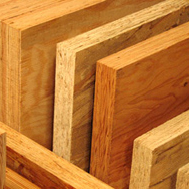Structural Composite Lumber
Structural Composite Lumber (SCL)
This ‘family’ of engineered wood products, designed for structural (load-bearing) use, consists of:
- Laminated veneer lumber (LVL)
- Parallel strand lumber (PSL)
- Laminated strand lumber (LSL)
- Oriented strand lumber (OSL)
Structural composite lumber (SCL) is created by layering dried and graded wood veneers, strands or flakes with exterior moisture resistant adhesives into blocks of material known as billets. The billets are cured in a heated press and then resawn into specified sizes.
American SCL products conform to the individual manufacturer’s proprietary standard and therefore do not follow a single voluntary US national standard. For design recommendations and product specifications, please refer to the individual manufacturer’s information.

Laminated Veneer Lumber (LVL)
LVL is the most widely used of the structural composite lumber products. It is produced by bonding thin wood veneers together in a large billet. The grain of all veneer is parallel to the long direction. The LVL billet is then sawn to desired dimensions depending on the construction application. The product has many uses, including lintels and beams, hip and valley rafters, scaffold boards and the flanges stock for prefabricated wood I-joists. Because LVL is made with scarfed or lapped jointed veneers, LVL is available in lengths far beyond conventional lumber lengths.
Parallel Strand Lumber (PSL)
PSL is manufactured from veneers clipped into long strands in parallel formation and bonded together with an adhesive to form the finished structural section. The average length-to-thickness ratio of the strands in PSL is at least 300. Like LVL and glulam, this product is used for beam and lintel applications where high bending strength is needed. PSL is also frequently used as load-bearing columns.
Laminated Strand Lumber (PSL)
Laminated strand lumber is made from flaked wood strands that have an average length-to-thickness ratio of at least 150. Combined with adhesive, the strands are orientated and formed into a large mat or billet and pressed. LSL is used in a variety of applications from studs to millwork components.
Oriented Strand Lumber (OSL)
Similar to LSL, oriented strand lumber is also made from flaked wood strands. The strand geometry for OSL results in an average length-to-thickness ratio of at least 75. Combined with an adhesive, the strands are oriented and formed into a large mat or billet and pressed. OSL is used in a variety of applications from studs to millwork components.
In structural composite lumber billets, the grain of each layer of veneer or flakes runs primarily in the same direction. The resulting products out-perform conventional lumber when either face- or edge-loaded. SCL is a solid, highly predicable and uniform engineered wood product that is sawn to consistent sizes and is virtually free from warping and splitting.
Typical uses for SCL include rafters, lintels, beams, joists, studs and columns. Two or three sections of SCL can be joined together to form 3-1/2 inch (89mm) to 5-1/2 inch (140mm) members. These thicker sections easily nest into 2×4 (51x102mm) or 2×6 (51x152mm) framed walls as lintels or columns.
